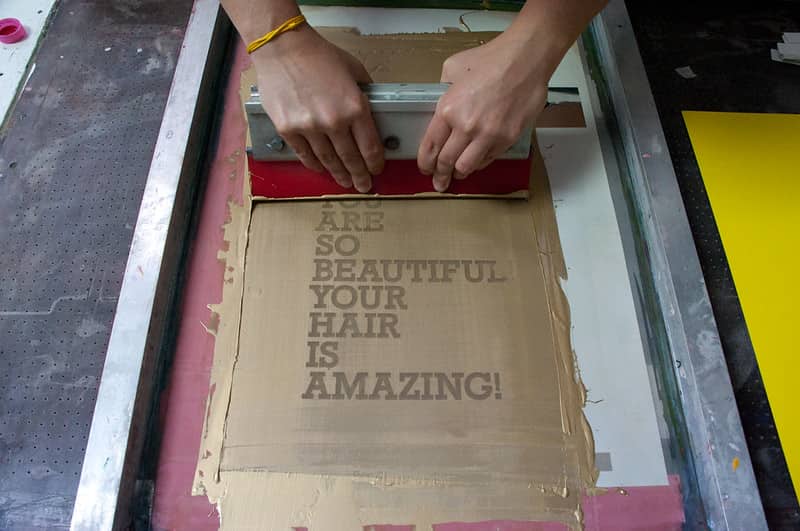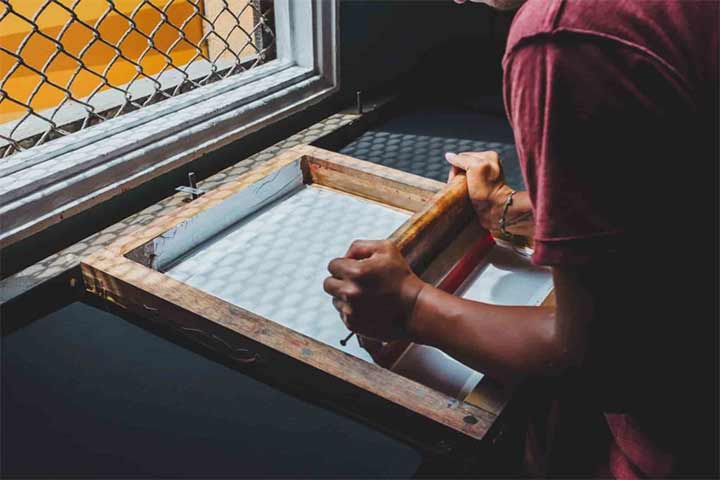The screen printing squeegee or squeegee looks like a simple tool, but it performs a very complex screen printing function. The main functions include the following four aspects:
- Moves the ink from the screen to the substrate.
- Wipe up the excess ink on the screen.
- Holds the screen to make contact with the substrate line.
- It makes it possible to print different forms of substrates.
The physical properties of the screen printing squeegee play a key role in printing, for example a high hardness squeegee can scrape off excess ink very well, but it does not meet the requirements of various shapes of the substrate. Therefore, when selecting the squeegee, the influence of performance factors on the above functions must be taken into account, to avoid negative effects on printing.
Índice de contenidos
Screen printing squeegee prices

The prices of squeegees for screen printing vary depending on the material in which it is made, for example, if it is aluminum or wood, its hardness and its size, which are chosen according to your printing work. In online stores you can find individual standards between USD 8 and USD 30 approximately. You also get them in a kit of various standards and it can be a little cheaper.
Homemade screen printing squeegee
Here is a video where you can see the step by step to build a homemade screen printing squeegee, yes, you will need some basic carpentry tools and you really want to. We hope you can do it yourself if you have the patience and the materials available, otherwise you can go for the option to buy one in the market.
How to make a screen printing squeegee?
- Measure and cut the wood slats
Depending on the size you need the squeegee, use a meter to mark on the wooden strip with the desired measurement. Cut two ribbons the same size.
Measure the width of the rubber rubber and mark the measurement of the notch where the rubber rubber will be inserted on the wood.
Use a woodworking tool that allows you to make the notch accurately.
Additionally, measure and perform the points of the upper part of the strip where the screws that will allow the parts to be assembled will be located. - Measure and cut the rubber rubber
Using the same measurement as the slats, cut the rubber band and place it in the notches in each slat.
- Assemble the parts: rubber slats and rubber
Assemble the three parts, the two slats and the rubber rubber by means of screws that are tight to prevent the rubber from moving or coming off and do its job properly. And ready!!!
Screen printing squeegee sharpener

Some of the problems that prevent the screen squeegee from performing properly in transferring ink to the substrate are dull edges, notches, and uneven profiles. Wear and tear can lead to squeegee blade defects, as well as exposure to inks and chemicals, mishandling, and improper storage. The squeegee sharpener is the tool used by screen printers to correct the edge of the squeegee blade so that it can return to its function.
Squeegee Sharpeners are available in a variety of sizes and configurations to accommodate a variety of squeegee sizes, performance requirements, and budgets.
Some types of squeegee sharpeners for screen printing are described below:
Squeegee grinders
They use abrasive components to remove material from the squeegee blade. Belt grinders are the oldest and use a continuous belt along the entire length of the squeegee blade so that it can be held against the belt during grinding. Wheels or pulleys drive the belt.
Squeegee cutters
Squeegee cutters use knives, either stationary or rotating, to remove material. Some machines heat the knives to make the cutting process easier.
Some squeegee cutters use regular knives or injector-style razor blades, but others need to use proprietary blade systems. In both cases, these machines can remove material from the squeegee blade and at the same time produce minimal amounts of waste. This quality makes squeegee cutters more common in industrial and specialty screen printing where production must be limited to a clean room.
Squeegee cutters are generally more expensive than belt and wheel grinding systems, but the performance they are designed for may outweigh the price.
Squeegee hardness for screen printing
The squeegee or squeegee is usually made of polyurethane. Together, the hardness, size and shape of the squeegee determine flexibility and pressure. Hardness is measured with a durometer and ranges from 55 degrees to 90 degrees. Values between 55-65 correspond to a low hardness squeegee, between 66-75 is medium hardness, more than 75 is high hardness.
The high hardness squeegee is very advantageous for the first three functions of the same described in the first paragraph of this article. The only shortcoming of the high hardness squeegee is that it cannot satisfy the printing of different shaped substrates.
Frequently asked questions about screen printing squeegees

It is a utensil that has a wooden or metal handle to which a thin and flexible rubber or plastic blade is assembled. It is used in screen printing to press ink across a printing screen and onto the substrate. The shape of the squeegee handle is a matter of comfort, but the shape of the blade affects the thickness of the deposited ink and the sharpness of the printed image. The squeegee profile is a cross-sectional representation of the blade, and is used to measure the shape of the blade. The most generic shape is square, and it is generally used for printing on flat substrates with standard poster inks. A flat dot double bevel shape (a cut triangle) is used to print on uneven surfaces, usually ceramic. A double bevel without a flat dot is convenient for casting a thin ink layer, for example when the stencil has intricate patterns. Single bevel blade is used to print on glass, square blade with rounded corners to print lighter colored inks on dark backgrounds, round edge to print on textiles such as T-shirts. When sharp edges of the blade are needed, a blade sharpener is used to grind the blade to the proper profile.
Proper squeegee care and maintenance is essential in screen printing for screen printers, as the squeegee is what actually puts ink on the substrate. Here are some basic tips to help ensure your prints look good and your squeegee lasts:
1. Clean the ink from your squeegee when you finish printing. The ink can damage the squeegee rubber and can cause long-term damage as the squeegee material absorbs the chemicals in your plastisol ink and can cause swelling and degradation of the squeegee blade.
2. When cleaning the ink, do not soak the squeegee blade in chemicals as the squeegee material will absorb the chemical liquid, and it will swell and soften. This means replacing the entire squeegee or changing the blade.
3. Store the clean squeegee in a safe place, out of direct sunlight, without storing or stacking on the squeegee blade.
4. Keep the squeegee blade sharp. With use and time, the edge of the squeegee blade will wear down and a sharp edge will become more rounded, degrading print quality. After a while, you will no longer be able to sharpen the squeegee material, so you will need to replace the squeegee material or get a new one.
Following these squeegee care recommendations will keep your manual and automatic printers printing well for a long time.
In general, you could say that there are no poor quality standards, but rather inappropriate standards for the particular print job. It is necessary to understand very well how each variable of the squeegee affects printing in general, so choosing the correct squeegee for each screen printing job will be an essential part and the most appropriate one will be selected through experience.

